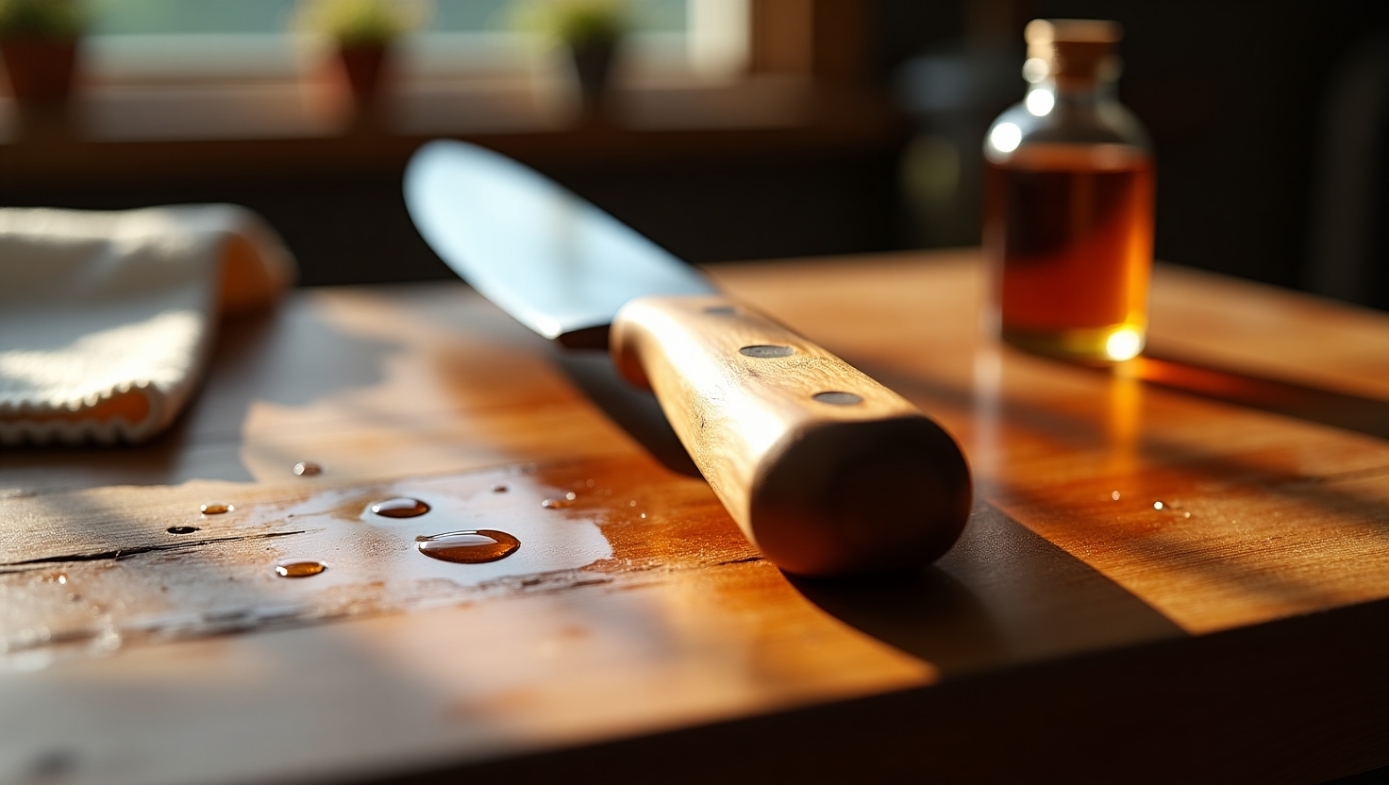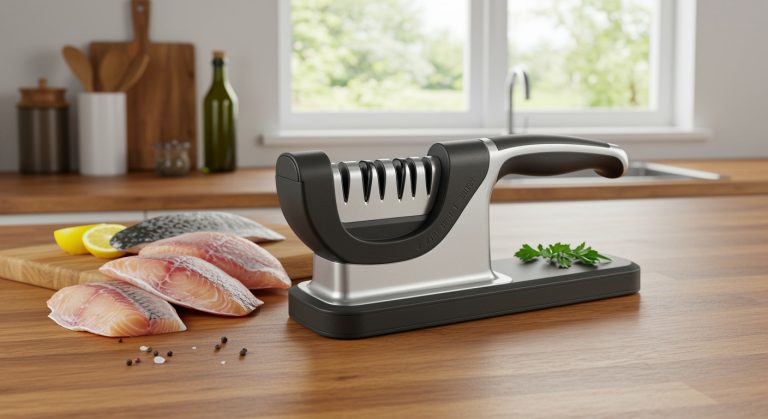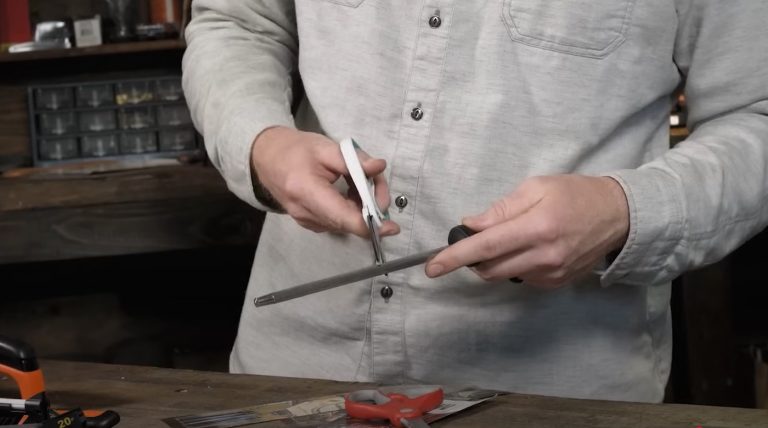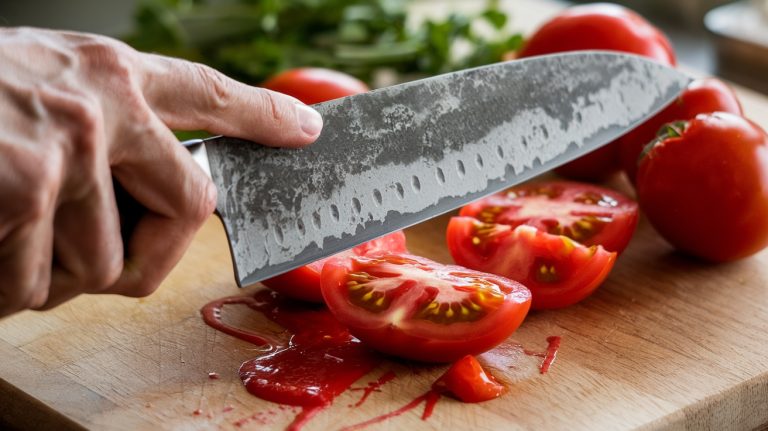Wooden Knife Handle Care: The Ultimate Guide
To care for your wooden knife handles, regularly clean them with warm, soapy water, avoiding prolonged soaking, and dry them immediately to prevent warping.
Use rubbing alcohol for tough grime, but skip harsh chemicals. Apply food-grade mineral oil monthly with a cloth to protect against cracking, wiping off excess after soaking.
Store knives in low-humidity spots like knife blocks or magnetic strips. Stick around to uncover deeper tips for lasting durability.
Key Takeaways
- Clean wooden knife handles with rubbing alcohol to remove grime, avoiding water soaking or dishwashers.
- Oil handles regularly with food-grade mineral oil to prevent drying and cracking.
- Sand with the grain using coarse to fine grits for a smooth finish.
- Store knives in low-humidity areas like knife blocks or magnetic strips.
- Hand-wash with mild detergent and dry immediately to prevent water damage.
Significance of Regular Maintenance
While it might seem like a minor task, regularly maintaining your wooden knife handle is essential for its longevity and performance.
You’ve got to prioritize this to prevent cracking and warping from environmental factors like humidity and temperature swings.
Proper care enhances durability, ensuring the wood doesn’t dry out or become brittle, while also preserving its natural shine and aesthetic appeal. Oiling the handle regularly helps to improve its resistance to changes in temperature and humidity.
Effective Oiling Methods
As you immerse yourself in maintaining your wooden knife handle, mastering effective oiling methods is key to preserving its condition.
Choose the right oil, like Danish Oil for deep penetration or Mineral Oil for moisture barriers, based on your wood type. Apply it with a clean cloth, using a few drops and rubbing with friction to aid absorption. Let it soak in, then wipe off excess to avoid a tacky layer.
Regular maintenance with the right products ensures that wood stays protected from atmospheric changes like dryness or humidity.
Here’s how to enhance your oiling technique:
- Test Oil First: Apply a small amount to check compatibility with your handle.
- Monitor Saturation: Stop when the wood no longer absorbs oil visibly.
- Consider Environment: Adjust frequency based on humidity and temperature.
- Use Sparingly: Avoid over-oiling to prevent sticky buildup.
Proper Cleaning Practices
Before you plunge into oiling your wooden knife handle, it’s essential to master proper cleaning practices to guarantee its longevity.
Start by using rubbing alcohol to lift grime without soaking the wood. A quick wipe with a silicon gun cleaning cloth can add shine. For stubborn stains, try steam cleaning to avoid over-saturation.
Never use harsh chemicals or soak the handle in water—avoid dishwashers at all costs. After use, rinse briefly and dry immediately with a towel to prevent warping from moisture. Prolonged exposure can cause swelling or cracking.
Post-cleaning, apply a thin layer of mineral oil or wax to protect against dryness. Regularly inspect for cracks, and don’t use olive oil—it can turn rancid.
Sanding for Smoothness
After ensuring your wooden knife handle is clean, turn your attention to sanding for a smooth, professional finish.
Start with coarse grit sandpaper (80-100) to shape the handle, then progress to finer grits (120, 220) for a refined surface. Always sand with the grain to avoid scratches, and apply light pressure to prevent heat buildup or burning the wood. Remember to follow a consistent grit progression to ensure no visible scratches remain from coarser stages consistent grit progression.
Begin with coarse sandpaper (80-100) to shape your knife handle, then switch to finer grits (120, 220) for a polished, smooth finish.
Use hand sanding for detailed contours or a belt sander for initial shaping.
Here’s how to sand effectively:
- Choose grit wisely: Start coarse, end fine (up to 400-600).
- Use tools smartly: Opt for sanding blocks for flat areas.
- Protect yourself: Wear masks and safety glasses against dust.
- Avoid over-sanding: Stop before creating uneven spots or damage.
Sealing and Protective Finishing
When sealing your wooden knife handle, start by applying multiple thin coats of a sealant like Danish oil or tung oil using a cotton cloth for even distribution, ensuring you avoid buildup that can lead to an uneven finish.
Don’t skimp on drying time between layers, as this guarantees the protective barrier fully sets before you add more.
For ongoing care, regularly inspect and reapply a conditioner or sealant to maintain the handle’s durability against moisture and wear. Additionally, consider wet sanding between coats to effectively fill pores and achieve a smoother finish wet sanding between coats.
Effective Sealing Methods
Many wooden knife handles require proper sealing to protect against moisture and wear, and choosing the right method can markedly extend their lifespan.
You’ll want to start by sanding the handle to at least 1200 grit for a smooth surface, then clean off debris. Test your chosen sealant—be it Danish oil for grain enhancement, polyurethane for water resistance, or a linseed oil and wax mix—on a hidden spot. Remember that no method offers complete waterproofing, as wood naturally absorbs moisture over time.
Consider these practical sealing tips:
- Apply thin coats using cotton fabric for even distribution.
- Buff the surface with steel wool after drying for a polished look.
- Allow proper drying time per manufacturer’s instructions.
- Try CA glue for a quick, durable seal, buffing for smoothness.
Regular Finish Maintenance
Having sealed your wooden knife handle effectively, it’s time to focus on ongoing care to keep that protection intact. Regularly inspect the handle for dryness or roughness, and reapply natural oils like boiled linseed oil or beeswax 2–4 times yearly to maintain moisture.
Sand lightly with 600–1200 grit sandpaper to smooth worn spots, then wipe away dust before conditioning. For a durable finish, apply thin layers of resin-based products, using lubricating oils for even coating. Let each layer dry fully, wiping between coats to avoid tackiness.
Store your knife in stable humidity, dry it immediately after washing, and test finishes on scrap wood first. Use lint-free cloths for buffing to guarantee a protective, polished shine.
Remember that oil finishes can enhance wood grain beautifully, offering both protection and a natural aesthetic appeal. Additionally, proper maintenance like oiling helps prevent cracking, especially with hardwoods like ironwood or ebony which are known for their exceptional durability.
Optimal Storage Solutions
When storing your wooden-handled knives, choose ideal locations like a dedicated drawer with dividers or a magnetic strip mounted securely on the wall to keep them accessible yet safe from damage.
Make certain you’re using protective covers or sheaths on the blades, especially in drawers, to shield the wooden handles from scratches and prevent moisture buildup.
This approach not only preserves the handle’s condition but also guarantees your safety by minimizing accidental contact with sharp edges.
Ideal Storage Locations
As you seek the best ways to store your wooden-handled knives, focusing on ideal storage solutions can greatly extend their lifespan and maintain their aesthetic appeal.
Choosing the right storage location is critical to prevent moisture buildup and physical damage to the handles. You’ve gotta prioritize dry, accessible spots that minimize wear. Storing knives properly also ensures longevity of the wooden handles by protecting them from environmental damage.
Consider these practical storage locations for excellent care:
- Knife Blocks: Keep them on countertops for visibility and organization while ensuring handles stay dry.
- Drawer Storage: Use designated slots with liners to control moisture in concealed, space-efficient setups.
- Magnetic Strips: Mount on walls for easy access and a modern look, saving counter space.
- Display Racks: Place in larger kitchens for aesthetic appeal and flexible storage options.
Protective Cover Usage
Before you store your wooden-handled knives, consider adding an extra layer of defense with protective covers to safeguard the handles from common threats.
These covers shield against moisture, scratches, dust, and minor impacts, preserving the handle’s aesthetic and integrity. Choose from options like durable leather, lightweight plastic, soft fabric, or custom wooden covers made from hardwoods like cocobolo.
Make sure the cover fits snugly, using materials like velvet lining to prevent abrasion. Proper care of these covers mirrors the attention needed for the wooden handles themselves, ensuring lasting durability.
Store covered knives in dry environments, avoiding extreme temperatures or pressure that could damage the cover or handle.
Regularly clean covers—condition leather, wipe down plastic—and inspect for wear.
Replace damaged covers promptly to maintain protection.
Careful Handling Tips
While maintaining your wooden knife handles, it’s crucial to handle them with care to preserve their integrity and longevity. Mishandling can lead to cracks, warping, or drying, so adopt precise habits.
Caring for wooden knife handles is essential to maintain their durability. Handle with care to prevent cracks, warping, or drying over time.
Don’t expose handles to extreme temperatures or humidity fluctuations, as these stress the wood. Store knives in a dry, stable environment to avoid moisture absorption. Additionally, regular oiling with food-safe products can help prevent water absorption and maintain the wood’s condition.
Consistent care, like using food-grade mineral oil, can also protect the wood from drying out and cracking over time.
Here’re some practical tips to guarantee careful handling:
- Hand-Wash Only: Clean your knives with warm, soapy water; never use a dishwasher to prevent cracking.
- Dry Promptly: Wipe the handle and blade dry immediately after washing to stop water damage.
- Limit Water Exposure: Avoid soaking handles in water for long periods.
- Skip Harsh Chemicals: Use mild detergents to protect the wood’s natural finish.
Frequently Asked Questions
Can Wooden Knife Handles Be Repaired if Cracked?
Hey, if you’re wondering whether you can repair cracked wooden handles, the answer’s yes!
Start by identifying the crack’s extent and cleaning the area. Grab CA glue or epoxy, and carefully work it into the crack using a thin tool.
Clamp the handle to secure alignment, and mask nearby areas to avoid mess. After it sets, sand the excess, apply a finish, and monitor for future issues.
Are There Specific Brands of Oil Recommended?
Hey, when you’re looking for specific brands of oil, you’ve got some solid options to evaluate.
Try Birchwood Casey Tru Oil for a mix of tung and linseed benefits, or Boo’s Block Board Cream for a food-safe blend of mineral oil and beeswax.
Don’t overlook standard Linseed Oil from various makers for protection, and Danish or Tung Oil from trusted brands for durability.
Pick what suits your needs best!
How Do I Identify Wood Type on Handles?
Ever wondered how to reveal the secrets hidden in wood’s silent story?
Immerse yourself and inspect your knife handle closely. Look for distinct colors—ebony’s deep black or koa’s golden-brown hues.
Check the grain; ziricote’s spider webbing or figured maple’s curly patterns stand out.
Feel the weight; desert ironwood’s heft is unmistakable.
Compare these traits against wood databases or consult experts to pinpoint the exact type with confidence.
Can I Use Olive Oil for Conditioning?
Hey, when you’re considering olive oil for conditioning, think twice before using it.
Olive oil can go rancid over time, leaving an unpleasant smell and sticky residue. Instead, opt for mineral oil, which won’t spoil and offers solid protection.
Apply a few drops to a clean towel, buff it in, and let it absorb for hours. You’ll avoid potential issues and keep things in top shape with this safer choice.
What Causes Wooden Handles to Discolor?
Hey, let’s explore what causes discoloration in wooden materials.
You’ll notice UV rays break down lignins, leading to graying, while water exposure triggers swelling and cracking, altering color.
Humidity shifts warp surfaces, and oils from handling or storage seep in, darkening tones.
Aging dries wood out, dulling vibrancy, and grime buildup adds stains.
Don’t overlook chemical reactions from cleaners or sweat—they degrade finishes, causing uneven, unsightly color changes over time.
Your Wooden Handle’s Lifeline Starts Here
So, you’ve got the know-how to keep your wooden knife handle in top shape. Think of it as a trusty ship steering through rough seas—regular care is your compass.
A buddy of mine neglected his, and within a year, cracks split the wood like a storm-torn hull. Don’t let that be you.
Maintain with oil, clean gently, sand, seal, store right, and handle with care. Your knife’ll last a lifetime!







